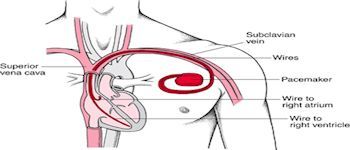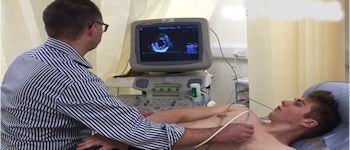Case studies
This page is intended to provide some insight into the range of cardiological cases that Dr Clarke deals with on a daily basis.
Each study is presented as a synopsis, with a link to further detail. These 'get more detail' links willl, in each case, take you to a series of slides that Dr Clarke has used in training junior staff.
Click on a title to go to a particular study.
Case study 1 Severe aortic stenosis
Case study 2 Cardiac collapse (syncope) masquerading as fainting attacks
Case study 3 Severe heart failure responding to CRT
Case study 4 Excellent blood pressure control
Case Study 1- Severe aortic stenosis
|
The first stage was to provide some stability through careful medication to create some heart reserve such that the invasive procedure had a realistic chance of success. The second stage was to prepare the patient with all necessary investigations and coordinate an urgent TAVI procedure. Lastly following the procedure careful medication and close follow-up ensured subsequent progressive recovery and long-lasting improvement in exercise capacity and breathlessness. Valve disease makes the heart work harder, causing it to fatigue and fail. This can steadily deteriorate over years or present in a more acute fashion. Often the only clue is a heart murmur heard with the stethoscope - which can be quickly assessed by a heart ultrasound scan or echocardiogram. This case describes an 88 year old man who was severely limited with breathlessness such that it took him three minutes to recover after putting his shirt on. With correct diagnosis and careful treatment a cardiologist can often make a patient fit for a special keyhole procedure - TAVI (Transcatheter aortic valve implantation) which replaces the severely narrowed main aortic valve and generally requires a hospital stay of 2-4 days Conclusion: Successful intervention with practical procedures in high risk cases requires careful coordination of care with regular review to optimise heart function and maximise recovery. |
Case Study 2- Cardiac collapse (syncope) masquerading as fainting attacks
Collapse due to a heart problem is termed syncope. The other main heart symptoms are chest discomfort, breathlessness, palpitations and fatigue. When patients lose consciousness the cause will be a heart rhythm disturbance, a seizure or blood pressure control / fainting event. This case describes a man who was having repeated blackouts where he had some warning, felt hot and collapsed. Historically these problems could occasionally take 6 months or even 1-2 years to diagnose. The decision to implant a loop recorder (or reveal device) by Dr Clarke was crucial. Several aspects of the history pointed to a benign condition. The loop recorder allowed early diagnosis of a serious life threatening condition.
An implantable recorder or 'reveal device' quickly showed that this was a life threatening rhythm disturbance. Implanting a defibrillator - implantable cardioverter defibrillator (ICD) protects the patient. It can quickly recognise the rhythm disturbance and try to pace terminate it by brief rapid stimulation of the heart or if required charge up in ten seconds and deliver a shock.
Often the correct diagnosis of a serious condition requires a high index of suspicion based on experience. Most conditions present in a standard way. Clinical experience allowed Dr Clarke to appreciate that an apparently benign condition with no adverse findings on ECG, examination or echocardiography was actually serious.
|
Case Study 3 - Severe heart failure responding to CRT - a specialised heart pacemaker that restores coordinated heart contraction
|
A 76- year old lady had her life transformed from being breathlessness on mild exertion with multiple hospital admissions. Her condition was returned to normal using this pacemaker device (CRT) performed in a 2 hour procedure as a day case,
The patient had continued to be unstable with frequent acute relapses of her heart failure despite standard heart failure medication. Dr Clarke stabilised her condition and so prevented recurrent life threatening hospitalisations by the addition of two medications which improve quality of life and survival - spironolactone and ivabradine. She also met criteria for a CRT-D or biventricular defibrillator to improve energy, reduce breathlessness, reduce deterioration and reduce risk of sudden death. The lady was very apprehensive about the procedure and required significant persuasion.
Within a few months of the procedure the patient was very well and returned to normal activities and has never looked back. Two years on her life remains good with no symptoms of heart failure.
(Heart failure remains a potentially serious condition. It is mainly treated with medication and where valve disease is the cause , by heart surgery. In the last ten years specialised pacemakers have been used to restore coordinated and efficient contraction of the pumping chamber. This is termed cardiac resynchronisation therapy. The procedure works by correcting the heart's damaged electrics.)
Get more detail... Back to case study list |
Case Study 4 - Excellent blood pressure control
|
Death rates from heart attacks and strokes have fallen from around 50% in the 1980's to less than a third by treatment of the four main risk factors - high blood pressure, smoking, diabetes and high cholesterol. For every 20 mmHg rise in systolic blood pressure in the range 115 mmHg up to 185 mmHg, the risk of cardiovascular disease doubles. Treatment of high blood pressure has been identified as the single most beneficial strategy for health world-wide.
Conclusion - Early and intensive treatment of high blood pressure can cause a dramatic reduction in risk and prevent largely unnecessary premature death.
|












